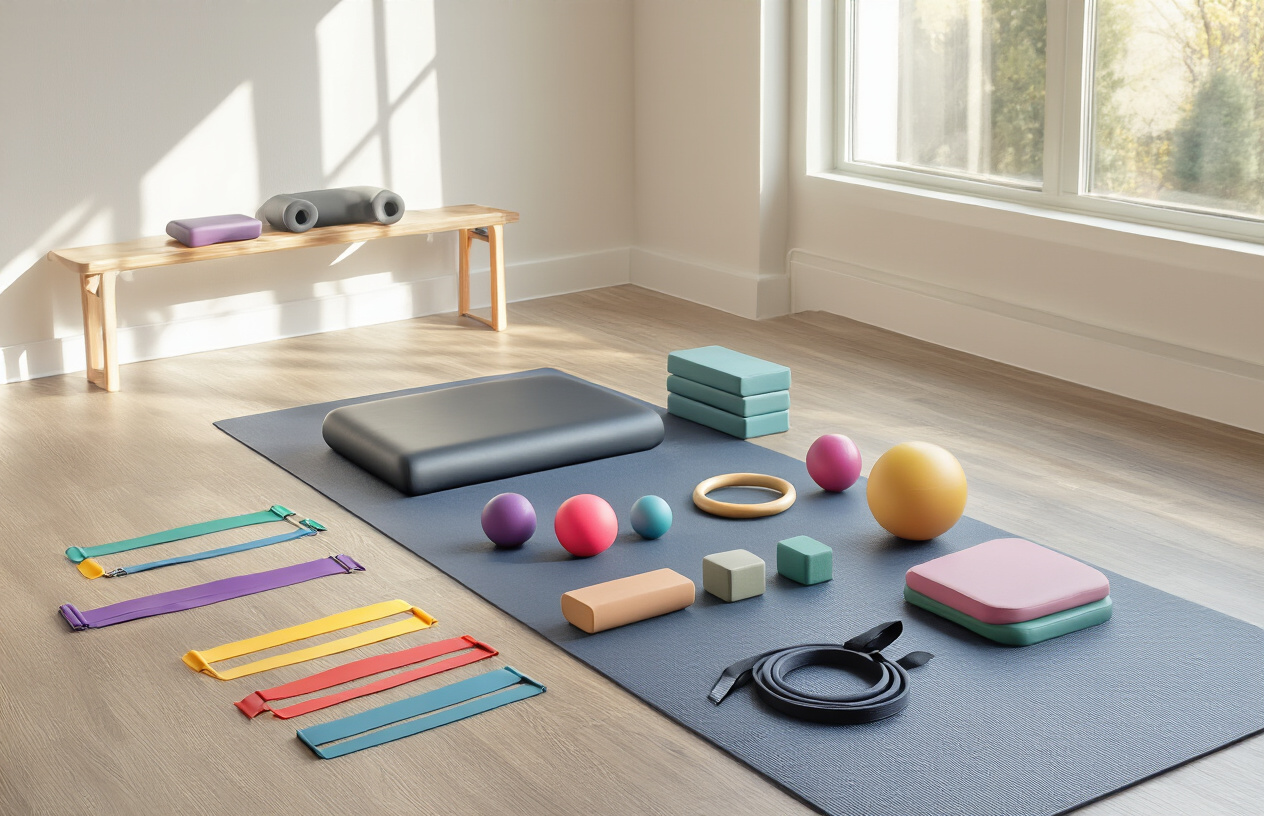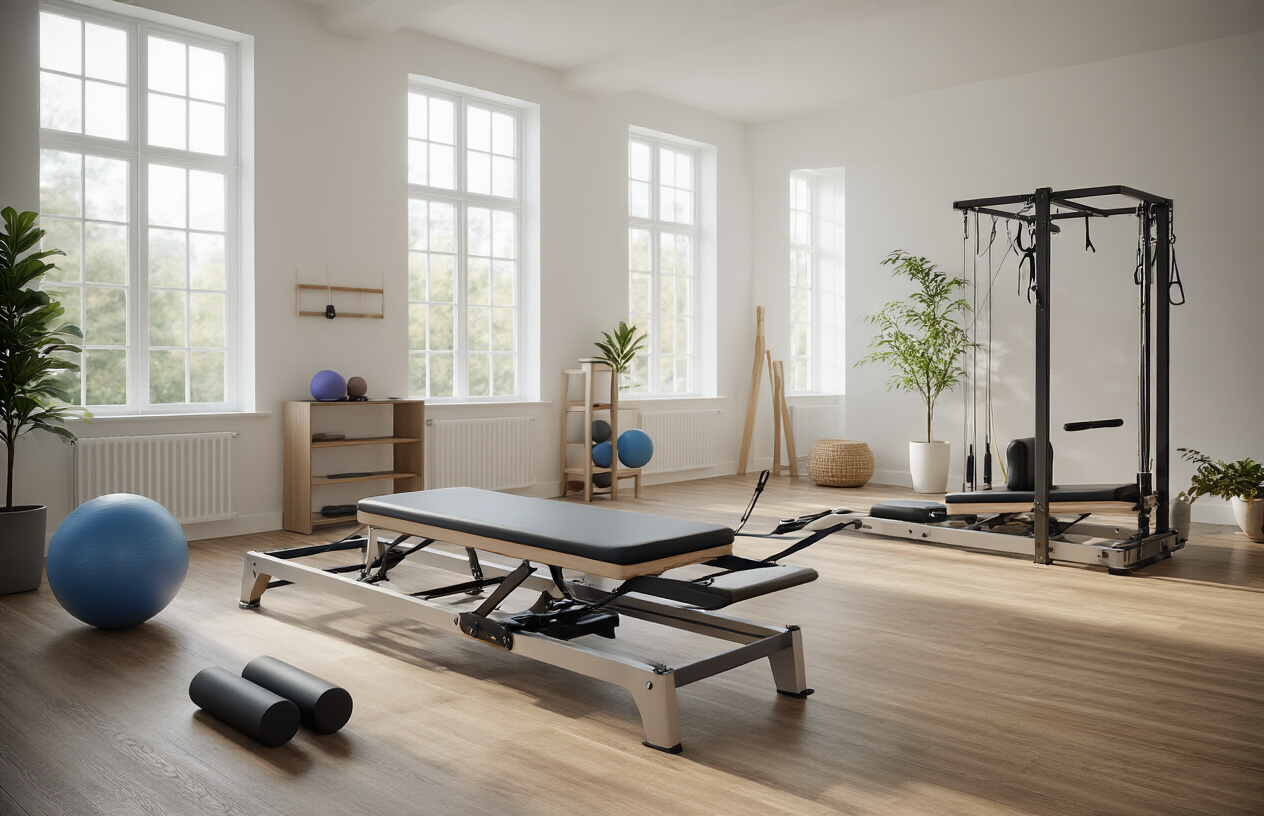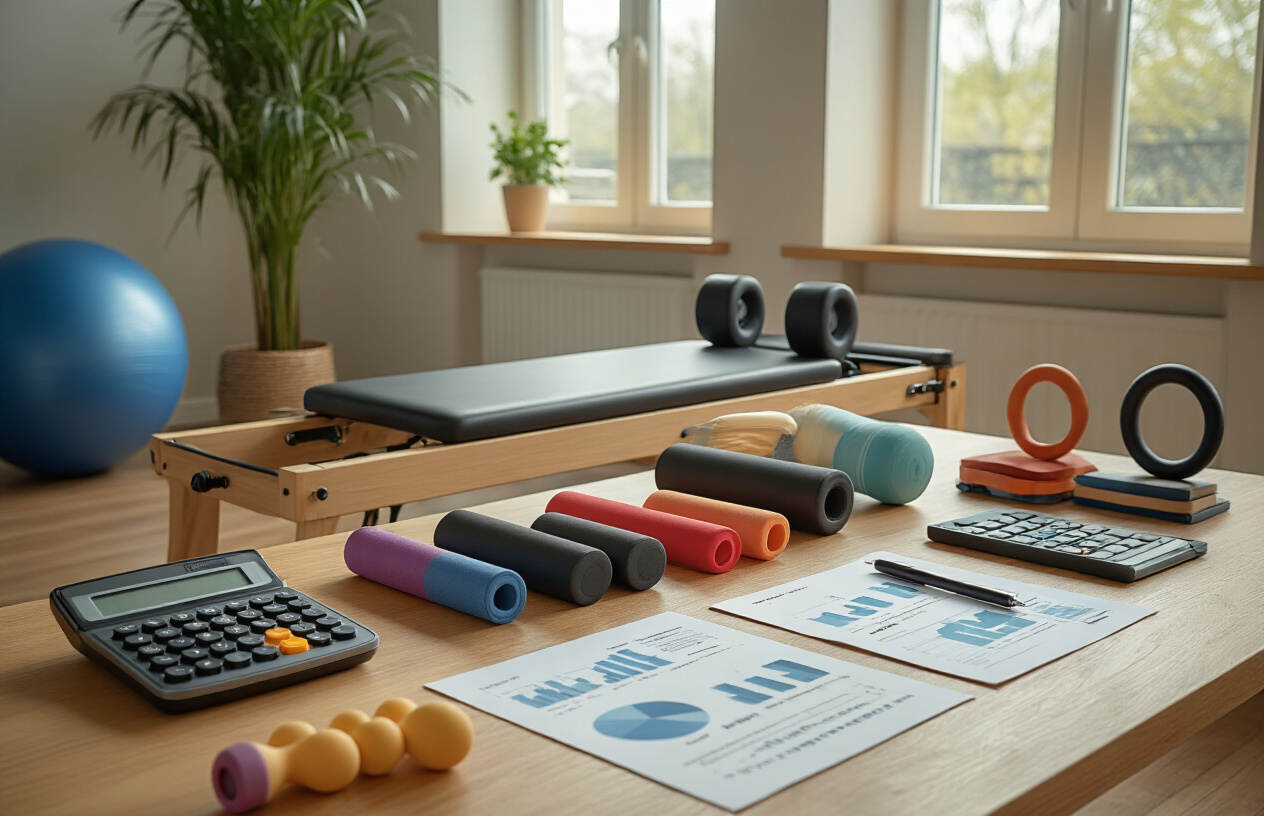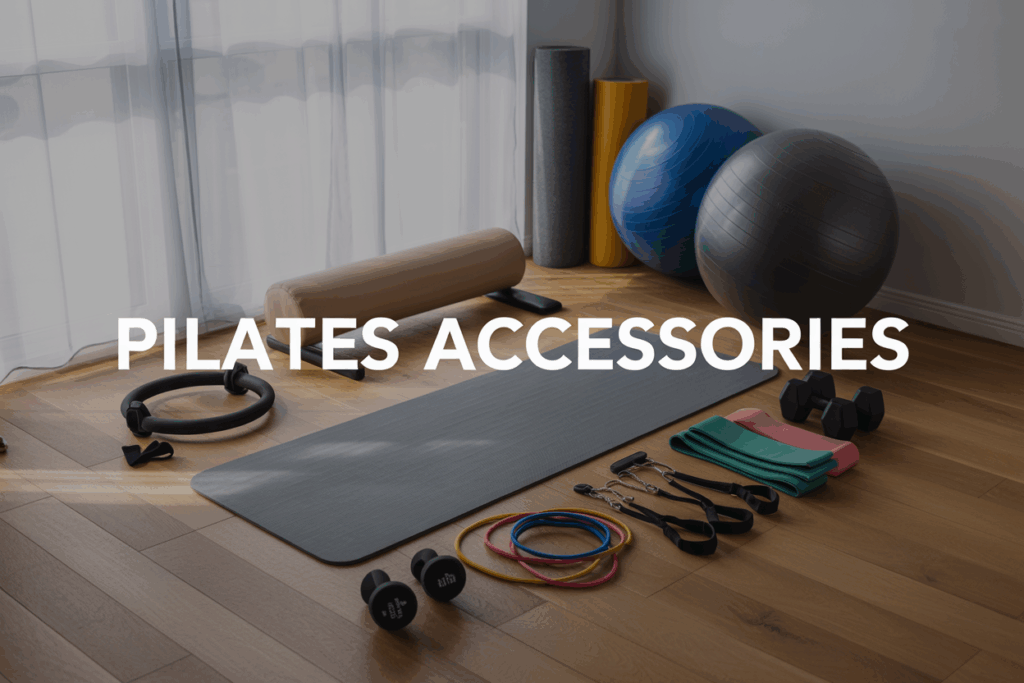Pilates Acessories
Pilates accessories can transform your home workouts from basic mat sessions into studio-quality training experiences. This guide is designed for fitness enthusiasts, Pilates beginners, and seasoned practitioners who want to build an effective home setup without breaking the bank.
We’ll explore essential mat-based equipment that every Pilates lover should own, plus core strengthening tools that add serious challenge to your routine. You’ll also discover reformer-style home equipment that brings that coveted studio experience right to your living room, and learn smart strategies for investing in gear that actually delivers results.
Essential Mat-Based Pilates Equipment

Premium Exercise Mats for Superior Comfort and Grip
The foundation of any successful mat-based Pilates practice starts with choosing the right exercise mat. Quality Pilates mats differ significantly from standard yoga mats in thickness, density, and material composition. Look for mats that are at least 10-15mm thick to provide adequate cushioning for your spine, hips, and knees during floor exercises.
Premium materials like natural rubber or high-density PVC offer exceptional grip and durability. These materials prevent slipping during dynamic movements while maintaining their shape after repeated use. Many professional-grade mats feature alignment guides printed on the surface, helping you maintain proper positioning throughout your workout.
When selecting a mat, consider the texture carefully. A slightly textured surface provides better grip without being rough on your skin. Closed-cell construction prevents moisture absorption, making the mat more hygienic and easier to clean. Some top-tier options include antimicrobial treatments that resist bacteria and odor buildup.
Size matters too. Standard mats measure 68 inches long, but taller practitioners benefit from extra-long versions measuring 72-84 inches. Width typically ranges from 24-26 inches, providing ample space for lateral movements without feeling cramped.
Pilates Blocks for Enhanced Support and Alignment
Pilates blocks serve as versatile props that transform challenging exercises into accessible movements while adding complexity to basic positions. These foam or cork accessories typically measure 9x6x3 inches, though sizes vary among manufacturers.
Foam blocks offer gentle support and are ideal for beginners working on flexibility and alignment. They compress slightly under pressure, creating a forgiving surface for sensitive areas. Cork blocks provide firmer support and greater stability, making them perfect for advanced practitioners who need solid resistance during strength-building exercises.
The primary benefit of blocks lies in their ability to bring the floor closer to you. When placed under your hands during seated forward folds or beneath your hips in supported child’s pose, blocks reduce strain while maintaining proper form. They also create height variations that help accommodate different body proportions and flexibility levels.
For core work, blocks add instability that engages deeper stabilizing muscles. Squeezing a block between your thighs during exercises like the hundred or single-leg stretches intensifies muscle activation throughout your inner thighs and pelvic floor.
Resistance Bands to Amplify Your Workout Intensity
Resistance bands revolutionize mat-based Pilates by adding variable resistance that challenges your muscles throughout their full range of motion. Unlike static weights, bands create accommodating resistance that increases as the band stretches, perfectly matching your muscle’s strength curve.
Loop bands, typically made from latex or fabric, excel at targeting the glutes, hips, and outer thighs. Place them around your ankles during side-lying leg lifts or around your thighs during bridge exercises to activate often-neglected stabilizing muscles. Fabric bands tend to be more comfortable against skin and don’t roll or pinch like latex versions.
Long resistance bands with handles open up countless upper body possibilities. These bands simulate many reformer exercises, allowing you to perform rowing movements, chest presses, and lat pulls from your mat. The variable resistance challenges your muscles differently than traditional weights, promoting functional strength and improved muscle coordination.
Different resistance levels serve various purposes. Light bands work well for rehabilitation and activation exercises, while heavy bands challenge even the strongest practitioners. Many bands use color-coding systems to indicate resistance levels, making it easy to progress systematically as your strength improves.
Quality bands maintain their elasticity over time and resist snapping during intense workouts. Look for bands with reinforced stress points and comfortable handles that won’t dig into your palms during extended sessions.
Core Strengthening Tools
Pilates Rings for Targeted Muscle Activation
The Pilates ring stands as one of the most versatile and effective accessories for precise muscle targeting. This spring-loaded circle creates resistance that challenges your muscles throughout the entire range of motion, making every squeeze count. When you press the ring between your palms, you activate deep stabilizing muscles in your shoulders and core that often get overlooked in traditional exercises.
Position the ring between your thighs during leg work, and you’ll feel your inner thighs fire up in ways you never imagined. The beauty lies in how this simple tool transforms basic movements into targeted strengthening exercises. Bridge poses become infinitely more challenging when you add a ring squeeze, engaging your glutes, inner thighs, and core simultaneously.
Professional instructors love rings because they provide immediate feedback. You can feel exactly when your muscles are working and when they’re slacking off. The resistance remains consistent whether you’re a beginner or advanced practitioner, making it perfect for progressive training.
Stability Balls to Challenge Your Balance and Form
Stability balls revolutionize your Pilates practice by introducing an element of instability that demands constant core engagement. Your body works overtime to maintain balance, recruiting deeper muscle layers that remain dormant during floor exercises. This constant micro-adjustment strengthens your entire kinetic chain from head to toe.
Rolling out into a plank position on the ball transforms a familiar exercise into a full-body challenge. Your core stabilizers work desperately to prevent you from rolling off, while your shoulders and arms maintain proper alignment. Even simple movements like pelvic tilts become exponentially more difficult when performed on an unstable surface.
The ball’s size matters significantly for effectiveness. Choose one that allows your hips and knees to form 90-degree angles when seated. Too small and you’ll strain your back; too large and you’ll struggle to maintain proper form.
Ab Wheels for Advanced Core Conditioning
Ab wheels represent the graduate-level course in core strengthening equipment. This deceptively simple tool delivers one of the most challenging core workouts available, engaging your entire anterior chain while demanding perfect form and control. The rolling motion forces your abs to work eccentrically, controlling the descent while preventing your back from arching dangerously.
Start from a kneeling position and roll forward slowly, maintaining a straight line from your knees to your head. Your core muscles work overtime to prevent collapse, while your shoulders stabilize the movement. The return phase proves even more challenging as you fight gravity to roll back to the starting position.
Progress gradually with ab wheels. Many people jump in too aggressively and end up with sore backs or strained shoulders. Master the kneeling version completely before attempting standing rollouts, which represent one of the most advanced bodyweight exercises possible.
Foam Rollers for Muscle Recovery and Flexibility
Foam rollers serve as your personal massage therapist, breaking up muscle tension and improving tissue quality between Pilates sessions. This self-myofascial release technique helps maintain the flexibility gains you achieve during your practice while preparing your muscles for future workouts.
Different roller densities provide varying levels of intensity. Softer rollers work well for sensitive areas and beginners, while firm rollers dig deeper into stubborn knots and tight spots. Textured rollers with bumps and ridges target specific trigger points more effectively than smooth versions.
Rolling technique matters enormously for results. Move slowly over each muscle group, spending extra time on particularly tight areas. Your IT bands, calves, and upper back typically need the most attention after Pilates sessions. The discomfort should feel like “good pain” – intense but not sharp or shooting.
Reformer-Style Home Equipment

Portable Pilates Reformers for Studio-Quality Workouts
The dream of bringing professional reformer workouts home becomes reality with portable versions designed for residential use. These compact machines deliver the same spring resistance system found in commercial studios, allowing you to perform hundreds of traditional reformer exercises from your living room. Popular models like the AeroPilates Premier and Stamina AeroPilates fold away for storage yet provide the full carriage movement essential for proper reformer technique.
Key features to look for include adjustable spring tension with at least four resistance levels, a smooth-gliding carriage system, and sturdy construction that can handle dynamic movements. Many portable reformers come with comprehensive workout DVDs and detailed exercise charts, making them perfect for beginners who want structured guidance. Advanced practitioners appreciate the ability to customize resistance combinations for challenging workouts that rival expensive studio sessions.
While these machines require a bigger upfront investment than basic accessories, they offer exceptional value when you consider the cost of regular studio classes. Most quality portable reformers range from $300 to $800, paying for themselves after just a few months of avoided studio fees. The convenience factor alone makes them worthwhile – no more rushing to make class times or dealing with crowded studios.
Sliding Discs to Create Challenging Resistance Training
Small but mighty, sliding discs transform any floor space into a challenging workout zone by creating instability that forces your core to work overtime. These smooth, lightweight discs slide effortlessly on carpet and come with fabric covers for hardwood floors, making them incredibly versatile for any home setup. Professional trainers love them because they add an element of controlled instability to traditional Pilates moves.
The magic happens when you place hands or feet on the discs during exercises. Simple moves like mountain climbers become intense core challenges as your muscles fight to maintain control while the discs want to slide away. Plank variations, lunges, and bridging exercises all become significantly more demanding when performed with sliding discs. They’re particularly effective for targeting deep stabilizing muscles that often get neglected in standard mat work.
What makes sliding discs so appealing is their ability to scale with your fitness level. Beginners can use them for gentle stretching and mobility work, while advanced practitioners can incorporate them into high-intensity interval training. They weigh practically nothing, pack flat in any bag, and cost under $20 for a quality set. Many physical therapists recommend them for injury prevention and rehabilitation work.
Pilates Chairs for Comprehensive Strength Building
The Pilates chair deserves recognition as one of the most underrated pieces of home equipment available today. Originally designed by Joseph Pilates himself, this compact powerhouse delivers full-body conditioning through its unique spring-loaded pedal system. Modern versions like the Balanced Body EXO Chair bring professional-grade functionality to home users who want serious strength training in a space-efficient package.
Chair workouts target every major muscle group through precise, controlled movements that build functional strength and coordination. The seated position eliminates the need for floor work, making it ideal for people with mobility limitations or those who prefer upright exercises. Push-ups performed on the chair’s pedals create variable resistance that adapts to your strength curve, providing optimal muscle activation throughout the entire range of motion.
Balance and proprioception improve dramatically with regular chair practice since many exercises require you to maintain stability while moving the pedals independently. This translates to better coordination and reduced injury risk in daily activities. Advanced users can perform incredibly challenging moves like single-leg squats and standing balance series that would be nearly impossible on other equipment. While chairs represent a bigger investment than basic accessories, their versatility and durability make them excellent long-term additions to any home Pilates setup.
Flexibility and Stretching Accessories
Yoga Straps for Deeper Stretches and Better Range of Motion
Yoga straps transform your Pilates practice by giving you the extra reach and stability needed for challenging stretches. These simple fabric loops help bridge the gap between where your body is now and where you want it to be. When your hamstrings feel tight during a seated forward fold, a strap wrapped around your feet allows you to maintain proper spine alignment while gradually working toward deeper flexibility.
The beauty of yoga straps lies in their ability to provide support without forcing your body into uncomfortable positions. You can adjust the length as your flexibility improves, making them perfect for progressive training. Many practitioners find straps particularly helpful for shoulder stretches, leg extensions, and spinal twists that would otherwise require a partner’s assistance.
Pilates Spine Correctors for Improved Posture
Spine correctors bring the precision of studio equipment into your home practice. These curved apparatus pieces support your natural spinal curves while encouraging proper alignment during exercises. The gentle arc helps decompress vertebrae and opens the chest, counteracting the forward head posture that comes from hours spent hunched over devices.
Working with a spine corrector teaches your body what good posture feels like. The equipment provides feedback through its shape, guiding you into positions that strengthen postural muscles and improve spinal mobility. Regular use can help reduce back pain and create lasting improvements in how you carry yourself throughout the day.
Massage Balls for Trigger Point Release
Small but mighty, massage balls target specific areas of tension with pinpoint accuracy. Unlike foam rollers that cover broad muscle groups, these compact tools allow you to work on knots and tight spots that traditional stretching might miss. Rolling a lacrosse-sized ball under your foot can release plantar fascia tension, while using one against a wall helps reach those stubborn spots between your shoulder blades.
The pressure you apply is completely under your control, making massage balls suitable for sensitive areas or acute trigger points. Many Pilates practitioners use them as part of their warm-up routine to prepare muscles for movement or as a cool-down tool to prevent soreness after intense sessions.
Stretching Aids for Enhanced Flexibility Goals
Dedicated stretching aids take the guesswork out of flexibility training. Devices like stretch boards for calf stretches or hip flexor tools provide consistent angles and support that help you progress safely. These tools often include measurement markers or adjustable settings that let you track improvements over time.
Unlike passive stretching where you rely on gravity or external force, many stretching aids engage your muscles actively. This approach builds strength in your new range of motion, making flexibility gains more stable and functional for real-world movement patterns.
Balance Pads for Proprioception Training
Balance pads introduce instability that challenges your proprioceptive system – your body’s ability to sense its position in space. Standing on these foam surfaces during Pilates exercises forces your deep stabilizing muscles to work harder, improving overall coordination and body awareness.
The unstable surface makes even simple movements more challenging and engaging. A basic single-leg stand becomes a full-body exercise when performed on a balance pad, recruiting muscles from your ankles to your core. This training translates directly into better balance and stability in daily activities, from walking on uneven surfaces to recovering from unexpected slips.
Smart Investment Strategies for Pilates Equipment

Budget-Friendly Options That Deliver Maximum Results
Starting your Pilates journey doesn’t require breaking the bank. A resistance band set, typically priced under $20, provides incredible versatility and can replicate many exercises performed on expensive reformer machines. These bands come in various resistance levels and often include door anchors, making them perfect for full-body workouts.
A quality Pilates ball costs around $15-25 and serves multiple purposes. You can use it for core strengthening, back support during mat work, and balance challenges. The ball’s unstable surface forces your deep stabilizing muscles to engage, creating an effective workout that rivals more expensive equipment.
Yoga blocks, though originally designed for yoga practice, work beautifully for Pilates modifications. At $10-15 each, they help with alignment and provide support when flexibility limitations prevent proper form. Many instructors recommend having two blocks for maximum versatility.
The Pilates ring, or magic circle, offers another budget-friendly option around $25-40. This simple metal or plastic ring with padded handles provides resistance training for arms, legs, and core muscles. Its compact size makes it perfect for travel workouts.
| Equipment | Price Range | Key Benefits |
|---|---|---|
| Resistance Bands | $15-30 | Full-body resistance, portable |
| Pilates Ball | $15-25 | Core stability, versatile |
| Yoga Blocks | $10-15 each | Alignment support, modifications |
| Pilates Ring | $25-40 | Targeted resistance, compact |
Professional-Grade Equipment for Serious Practitioners
Serious Pilates enthusiasts often invest in professional-grade equipment that mirrors studio quality. A high-end reformer for home use ranges from $2,000-$8,000, but provides the authentic Pilates experience with smooth carriage movement, adjustable springs, and precise alignment guides.
The Cadillac or trap table represents the pinnacle of Pilates equipment. These $4,000-$12,000 machines offer endless exercise possibilities with their spring-loaded towers, roll-down bars, and various attachment points. Physical therapists and advanced practitioners often prefer this equipment for its rehabilitation and advanced training capabilities.
Professional stability chairs cost $1,500-$3,500 and provide intense workouts in a compact footprint. These chairs challenge balance and core strength while offering upper and lower body exercises. Many celebrities and professional athletes rely on chair workouts for their efficiency and effectiveness.
High-quality reformers feature precision engineering with ball-bearing carriage systems, multiple spring tensions, and adjustable foot bars. Brands like Balanced Body, Peak Pilates, and Stott Pilates dominate the professional market with equipment built to withstand daily studio use.
When investing in professional equipment, consider warranty coverage, customer support, and upgrade options. Many manufacturers offer financing plans that make these investments more manageable for serious home practitioners.
Space-Saving Solutions for Small Home Gyms
Small spaces don’t mean compromising your Pilates practice. Wall-mounted pulley systems occupy minimal floor space while providing reformer-style resistance training. These systems fold flat against walls when not in use and cost significantly less than full reformers.
Stackable equipment proves invaluable in tight quarters. Foam rollers nest inside each other, resistance bands store in small drawers, and lightweight props stack efficiently. Create designated storage areas with clear containers to keep your space organized and equipment easily accessible.
Portable reformers offer a middle ground between full-size machines and basic props. These units, weighing 40-60 pounds, provide authentic reformer experiences while folding for storage under beds or in closets. Prices range from $800-$2,500, making them accessible alternatives to studio equipment.
Multi-level storage solutions maximize vertical space. Wall-mounted racks hold multiple props, while over-door organizers store smaller accessories. Rolling carts provide mobile storage that moves easily between workout areas and storage spaces.
Consider equipment with dual purposes for storage. Ottoman storage benches hold props while providing seating, and exercise balls double as desk chairs in home offices. These solutions help equipment earn its space in your home.
Multi-Purpose Tools That Replace Multiple Accessories
Smart equipment choices eliminate the need for multiple single-purpose tools. Adjustable dumbbells replace entire weight sets while serving as Pilates props for resistance work. Their compact design saves space while providing weight options from 5-50 pounds per dumbbell.
Suspension trainers like TRX systems create hundreds of exercise possibilities using just body weight and gravity. These systems work for strength training, flexibility, balance, and core work. The entire system weighs less than two pounds and fits in a small bag.
Foam rollers serve triple duty as prop support, myofascial release tools, and balance challenges. Higher-density rollers provide deeper tissue work, while softer versions work better for support and balance exercises. Some models include vibration features for enhanced muscle recovery.
Resistance bands with multiple attachment points replace various Pilates springs and cables. Complete band systems include door anchors, ankle straps, and handles, creating reformer-like resistance patterns. Quality sets provide resistance equivalent to 10-150 pounds of weight.
Stability balls function as chairs, back support, balance tools, and resistance equipment. Professional-grade balls support up to 2,000 pounds and maintain their shape through thousands of uses. Different sizes accommodate various body types and exercise modifications.
The key to smart multi-purpose investments lies in choosing quality over quantity. One well-made piece of versatile equipment often provides better value than multiple cheaper, single-purpose items that may break or become obsolete.
The right Pilates accessories can transform your home workout routine from basic to brilliant. Mat-based equipment, core strengthening tools, and reformer-style gear give you endless ways to challenge your body and keep your sessions fresh. Flexibility accessories help you reach deeper stretches and better alignment, while smart shopping strategies ensure you get quality equipment without breaking the bank.
Start with the basics – a good mat and resistance band will take you far. As you grow stronger and more committed to your practice, gradually add pieces that match your goals and space. Remember, the best Pilates equipment is the kind you’ll actually use consistently. Choose accessories that excite you about working out, fit your budget, and work well in your home setup.
Do you know Balmorex Pro?



$ 69,00Original price was: $ 69,00.$ 49,00Current price is: $ 49,00.$ 99,00Original price was: $ 99,00.$ 79,00Current price is: $ 79,00.